Penetration testing requires careful planning and execution to effectively identify security vulnerabilities while maintaining system integrity.
Professional pentesters follow established methodologies and guidelines to ensure thorough assessment without causing harm to production systems.
This guide outlines key best practices for conducting effective, ethical, and legally-compliant penetration tests.
Pre-Testing Requirements
- Obtain written authorization from system owners
- Define clear scope and boundaries
- Document test objectives and success criteria
- Create emergency contact procedures
- Review legal compliance requirements
Testing Methodology
Follow industry-standard frameworks like OSSTMM, PTES, or OWASP Testing Guide.
- Information gathering and reconnaissance
- Vulnerability scanning and identification
- Exploitation and privilege escalation
- Post-exploitation analysis
- Documentation and reporting
Safety Measures
- Create system backups before testing
- Test during off-peak hours
- Monitor system health during tests
- Maintain constant communication with stakeholders
- Document all actions taken
Tool Selection
Choose appropriate tools based on test objectives:
| Category | Recommended Tools |
|---|---|
| Reconnaissance | Nmap, Maltego, Recon-ng |
| Vulnerability Assessment | Nessus, OpenVAS, Acunetix |
| Exploitation | Metasploit, Burp Suite, SQLmap |
Documentation Requirements
- Test scope and objectives
- Methodology used
- Tools and techniques employed
- Vulnerabilities discovered
- Risk assessment
- Remediation recommendations
Ethical Considerations
- Respect data privacy
- Avoid unnecessary system disruption
- Report vulnerabilities responsibly
- Maintain client confidentiality
Reporting Guidelines
Structure reports with these essential sections:
- Executive Summary
- Technical Findings
- Risk Rankings
- Remediation Steps
- Supporting Evidence
Moving Forward: Implementing Changes
Schedule regular penetration tests to maintain security posture.
- Quarterly testing for critical systems
- Annual comprehensive assessments
- Post-major-change verification
- Continuous vulnerability monitoring
Contact certified penetration testing organizations like Offensive Security or SANS Institute for professional assistance.
Post-Test Actions
- Review findings with stakeholders
- Prioritize vulnerability remediation
- Validate fixes through retesting
- Update security documentation
- Adjust security policies as needed
Compliance and Regulations
- Ensure adherence to industry standards
- Document regulatory compliance
- Maintain testing certifications
- Follow data protection laws
- Keep audit trails
Common Pitfalls to Avoid
- Exceeding authorized scope
- Inadequate documentation
- Poor communication with stakeholders
- Neglecting system restoration
- Rushing through testing phases
Building a Sustainable Security Program
Integrate penetration testing into your broader security strategy:
- Establish continuous assessment cycles
- Develop internal testing capabilities
- Maintain updated testing procedures
- Track security improvements over time
- Foster security-aware culture
Securing Tomorrow’s Systems Today
Effective penetration testing remains critical for maintaining robust security postures. Organizations must commit to regular assessments, proper methodology, and continuous improvement. By following these guidelines and best practices, teams can conduct thorough, effective, and responsible security assessments that genuinely enhance system security.
FAQs
- What are the essential steps before starting a penetration test?
Obtain written authorization, define scope and boundaries, establish emergency contacts, determine testing window, and sign legal documents including non-disclosure agreements. - What documentation should be maintained during penetration testing?
Detailed logs of all activities, screenshots of findings, timestamps of tests performed, tools used, vulnerabilities discovered, and step-by-step methodology of exploitation attempts. - How should sensitive data discovered during testing be handled?
Encrypt all sensitive findings, restrict access to authorized personnel only, maintain confidentiality, and securely dispose of data after the engagement as per agreement. - What are the rules for testing production environments?
Avoid denial-of-service conditions, test during approved time windows, use non-destructive testing methods, and maintain constant communication with system owners. - Should social engineering be included in penetration tests?
Only if explicitly defined in scope and with written permission, ensuring compliance with legal requirements and protecting employee privacy. - What should be included in the final penetration testing report?
Executive summary, methodology, findings with severity ratings, proof of concept, impact analysis, and detailed remediation recommendations. - How should zero-day vulnerabilities discovered during testing be handled?
Immediately notify the client’s security team, follow responsible disclosure procedures, and provide technical details only to authorized personnel. - What are the requirements for testing third-party systems or cloud services?
Obtain permission from both the client and third-party provider, verify testing is allowed under service agreements, and adhere to cloud provider’s testing policies. - How should client credentials and access be managed during testing?
Use temporary credentials when possible, document all access levels, change passwords after testing, and never share or reuse credentials between engagements. - What should be done if critical systems are accidentally impacted?
Immediately stop testing, notify emergency contacts, document the incident, assist in recovery if requested, and provide detailed incident report.







